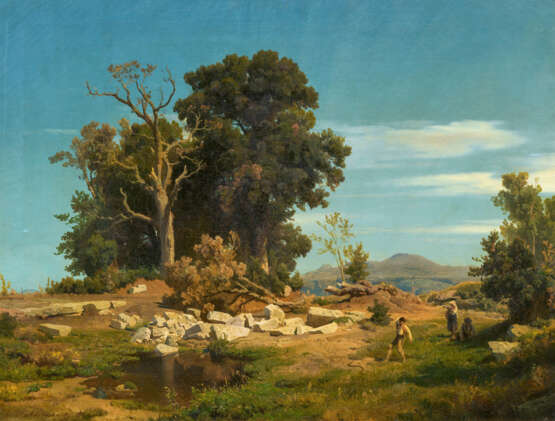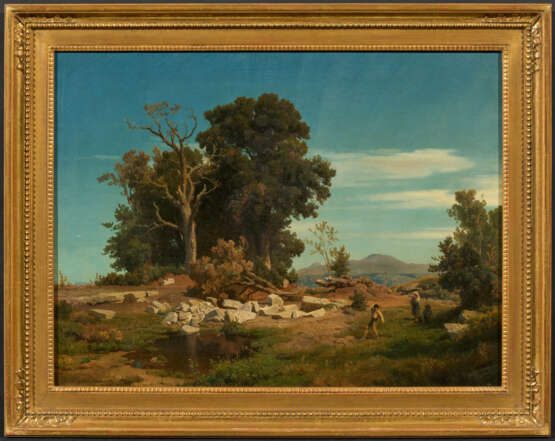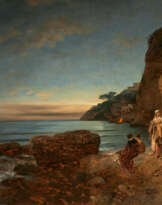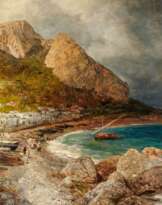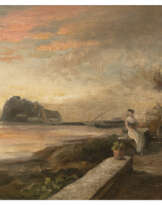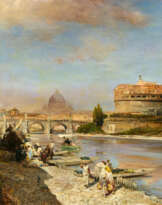ID 1319862
Lot 1293 | Oswald Achenbach. In the Albanian Mountains
Estimate value
€ 6 000 – 9 000
Düsseldorf 1827 - 1905
Title:
In the Albanian Mountains.
On the Right a Boy Chases away a Snake.
Technique:
Oil on canvas.
Measurement:
46.5 x 63.2cm.
Notation:
Signed lower left: "Osw. Achenbach".
Frame:
Framed.
Provenance:
Private ownership, Germany;
Art shop Gebr. Schöninger, Munich (label remnant on verso).
Oswald Achenbach's career as an artist was quite straightforward - very steep: The younger brother of Andreas Achenbach, who had already attracted attention at the Düsseldorf Art Academy as being exceptionally talented but also rebellious, was admitted as a student there as a child. He studied there for six years, until 1841, but always remained a pupil in the elementary class and drew. It was not until 1843, after leaving the academy, that he created his earliest, now well-known oil paintings on the first of seven trips to Italy.
Italy became Oswald Achenbach's passion. He returned there again and again, accompanied by painter friends or his family. The artist sent paintings he had made in Italy back to the Rhineland. However, he painted sketches much more frequently and amassed a large stock of motifs, which he realised in large paintings in Düsseldorf. His "View to the South" made him a favourite with the public. Collectors from all over Germany, Europe and the USA sought out a painting by Oswald Achenbach. His feeling for colour values and light moods with a free application of paint, influenced by Impressionism, set him apart from the crowd of 'Italian painters'. The art world and society honoured the painter. Honours and medals from all over Europe are proof of this.
Seven paintings by the artist are presented here. Each of them shows the great colourist Oswald Achenbach, but also reveals the storyteller that he was:
The earliest work (catalogue 1293) 'In the Alban Hills' is probably in connection with Achenbach's second trip to Italy in 1850, which took him to Rome for the first time (together with Albert Flamm (see catalogue 1302, 1303)). The composition of the painting with the central group of oak trees still reveals the influence of Johann Wilhelm Schirmer on the young painter. In this atmospheric landscape painting, the portrayed story of the boy chasing away a snake is an almost incidental, yet dramatic detail.
One of Rome's landmarks is Castel Sant'Angelo, and the view from the far bank of the Tiber of the ancient building, the Bridge of Angels and St Peter's Basilica in the distance is still one of THE motifs of the eternal city.
Catalogue 1294 shows the "spectacular view" in the bright light of the early day.
Achenbach's palette in light blue and light beige contrasts with the heavily shaded left foreground.
The Hamburger Kunsthalle owns the almost identical motif in evening mood, which Oswald Achenbach painted in 1883.
On his way to Rome - and also on other occasions - Oswald Achenbach was travelling to Switzerland.
In Basel, he captured the 'View of Basel Minster from the Middle Rhine Bridge' (catalogue 1298).
As is so often the case, the painter chooses an elevated perspective on the scene.
The painting is horizontally structured in four parallel "layers": Bridge railing - river - city skyline - sky provide an intriguing background for the everyday people on the bridge. Anyone standing at the "Spiaggia dei Pescatore" on Ischia today can enjoy the same view that Oswald Achenbach depicted in his painting dated 1884 (catalogue 1296).
The scene with the landmark of the Castello Aragonese off the coast is bathed in a soft sunset glow.
The figures placed by the painter in the foreground and on the beach give the eye cause to linger. Oswald Achenbach was also an amateur actor and director, and this painting once again demonstrates his talent for harmoniously enriching a well-known veduta with a narrative foreground.
The situation is similar with catalogue 1295: "In the park of the Villa Borghese", various groups of people have come together, looking like a cross-section of Roman society: Old and young, rich and poor, clergy, citizens and authorities are probably enjoying a Sunday afternoon on a warm autumn day.
The prominent architecture is only captured at the margins of the painting; mighty trees, painted in an Impressionist ductus, and stone balustrades surround the "stage" of the park meadow. A variant of this painting, which has a different lighting mood, is now in the collection of the Düsseldorf Kunstpalast.
In the painting 'View over the Gulf of Naples' (catalogue 1297), dated 1889, on the other hand, Oswald Achenbach almost entirely dispenses with human figures. The "star of the scene" is the rainbow, which becomes visible in the special weather constellation, the combination of rain and sunshine. A "picturesque'" event that the artist depicted several times and that demanded his full virtuosity as a director of light. The most eventful painting of Oswald Achenbach's works presented here is "The Eruption of Vesuvius" from 1890 (catalogue 1299). Strictly speaking, this is a historical painting, as the painter depicts the panic among the people of Naples when the volcano erupted in 1872. In Via Ponte della Maddalena, people flee from the deadly yet fascinating natural spectacle that is visible all too closely.
Others pray to St Januarius, the patron saint of Naples, whose power is said to have protected the city during an eruption of Mount Vesuvius in 1767 .A painting in the collection of the Düsseldorf Museum Kunstpalast shows the same place in a less dramatic light, in the evening during an approaching storm.
The perspective of the monument to the saint is identical. However, a comparison of the two paintings makes it clear how much freedom Oswald Achenbach allowed himself with the arrangement of the "backdrop" architecture.
Eight works by Oswald's brother Andreas Achenbach, twelve years his senior, can also be showcased this autumn. His domain is the seascapes and landscapes "north of the Alps". This is because the brothers of the same name divide up the market; their specialisation increases their desirability among collectors. Andreas Achenbach's virtuosity, especially in the depiction of water and dramatic seafaring situations, can be admired in the paintings from various phases of his oeuvre on display here.
| Artist: | Oswald Achenbach (1827 - 1905) |
|---|---|
| Applied technique: | Oil |
| Auction house category: | Paintings by newer masters |
| Artist: | Oswald Achenbach (1827 - 1905) |
|---|---|
| Applied technique: | Oil |
| Auction house category: | Paintings by newer masters |
| Address of auction |
VAN HAM Kunstauktionen GmbH Hitzelerstr. 2 50968 Köln Germany | ||||||||||||||
|---|---|---|---|---|---|---|---|---|---|---|---|---|---|---|---|
| Preview | |||||||||||||||
| Phone | +49 221 92586215 | ||||||||||||||
| Fax | +49 221 92 58 62 4 | ||||||||||||||
| Buyer Premium | 32% | ||||||||||||||
| Conditions of purchase | Conditions of purchase | ||||||||||||||
| Business hours | Business hours
|
